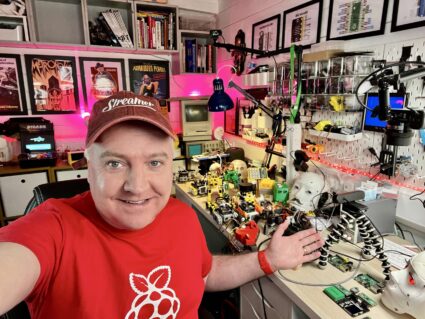After years of watching glumly from the sidelines as a nimble new start-up – ChatGPT – ate its lunch and soared to record-breaking, worldwide popularity, Google has finally decried ‘enough is enough’ and released a new chatbot that’s literally in a league its own.
Dubbed Gemini 3.0, the new AI definitively dusts its nearest overall competitor – ChatGPT-5.1 – in so many benchmark tests, its as if ChatGPT-5.1 has been relegated to boxing in a pick-up match in a friend’s backyard while Gemini 3.0 shows up for a global, pay-per-view special and finds no competitor is worthy to share the ring with it.
Essentially, Gemini 3.0 finds itself punching down at ChatGPT-5.1 many times over when it comes to overall IQ intelligence, overall world knowledge, overall savvy to run a business, overall ability to work with long documents, images and search results and overall, similar skills (see ‘Under the Hood’ below).
Plus, Gemini 3.0 completely mortifies ChatGPT-5.1 on an especially key metric: The ability to understand and work with buttons, icons and other tools served up by Web sites and apps on a computer screen – a fundamental skill needed for AI agents that are looking to interact with the digital world.
Put another way, Gemini 3.0 is not just much better at working with a computer screen.
It’s night-and-day better.
Meanwhile, Gemini 3.0 and its new powers are also being integrated in apps and tools throughout the Google universe – including Google Workspace Apps – to help ensure that Google users never need to leave the Google universe, ever, to apply AI to virtually any imaginable task.
It’s as if the 800-pound gorilla in the room finally stood-up, beat its chest with its fists and bellowed: Hey, I think you forgot something. I’m the 800-pound gorilla in the room.
And with that, it became heavyweight champion of the AI world.
Short-term, it’s tough to see how ChatGPT recovers, given that ChatGPT’s last major update was released just a few months ago.
Long-term, ChatGPT – and other AI engines – will hopefully be able to lift themselves off the mat, bring themselves back up to fighting weight and give Google another taste of the ring ropes.
In the meantime, for a great, 13-minute video review on all that Gemini 3.0 has to offer, check-out this excellent take by AI expert Alex Finn.
If you’re looking to take a deeper dive from the maker’s point-of-view, Google has released 12-article collection on Gemini 3.0, which offers a number of video demos.
Finally, if you want a bit more on what all the fuss is about, check-out “Key New Features/Enhancements” and “Under the Hood” –- an in-depth look at how Gemini 3.0 lunged ahead of ChatGPT-5.1 on critical benchmark tests — below:
Gemini 3.0 Key New Features/Enhancements
*Apparent Killer Creative Writing Ability: Although results are preliminary, early tests reveal that Gemini 3.0’s creative writing ability is superb. An early test by Writing Secrets, for example, revealed that the AI engine is excellent at creative writing, does about 80% of the heavy lifting for you, build memorable characters and scenes and auto-generates scores of turns-of-phrase that leave creative writers longing, ‘I wish I’d written that.”
*Brings Your Imagination to Life: Offer Gemini 3.0 a few ideas, a sketch or some scribblings/doodlings you made on the back of a napkin and it will auto-generate intelligent narrative, imaging, Web sites, apps – and more for you – on the spot.
*Master Level Analysis of Your Videos: Ask Gemini 3.0 to analyze your advertising video for you and it will come back with a detailed report featuring its view on what works and what doesn’t. Ditto for a video of your tennis, golf or pickle ball game.
*On-Board Memory That Gets to Know You: Like ChatGPT-5.1, Gemini 3.0 saves your chats to distill your likes, dislikes, work-style and similar in an effort to serve-up ever-more-customized responses over time.
*Answers Google Search Queries Using Text, Charts, Graphs, Images, Audio, Animations and/or Video, Where Applicable: This latest version of Gemini strives mightily to leverage all forms of knowledge, no matter where Gemini 3.0 pops-up in the Google universe.
Consequently, expect increasing number of responses when using Google Search in AI mode to feature answers to feature multiple forms of content in an effort to offer-up the most lucid, in-depth response as possible.
*Full Integration of Gemini 3.0 Throughout the Google Universe: This is one of Gemini 3.0’s key advantages: The ability to seamlessly integrate with tools and apps throughout the Google Universe, including Google Workspace and its apps like Google Docs, Gmail, Calendar, Contacts, Chat Sheets as well as NotebookLM, AppSheet, Apps Script. The overarching idea: You never need to leave the Google Universe, no matter what your need.
*Stronger Vibe Coding: One of the great long-term promises of AI is to offer everyday, non-technical users the ability spin-up their own apps by simply having a conversation with AI about what they want – or vibe coding. The feature has not been perfected yet, but Gemini 3.0 promises it has been enhanced with this latest version.
*Enhanced Agent Building (for Google Ultra Subscribers Only): While the promise of error-free AI agents – designed to perform a number of multi-step tasks for you without supervision – is still more of a goal that a shrink-wrapped product, Gemini 3.0 doubles down on meeting that horizon with a new agent builder that works with Gemini 3.0 – Antigravity. Alas, for now, that new capability is available only to big spender Google Ultra subscribers.
Gemini 3.0: Under the Hood
Here’s how Gemini 3.0 stacks-up against its overall closest competition, ChatGPT-5.1 on key, benchmark tests:
*Leagues above when it comes to correctly answering questions based on the onboard knowledge stored in its neural database – rather than going to the Web or another third party for help (SimpleQA Verified test).
–Gemini 3.0: 72.1% accuracy
–ChatGPT 5.1: 34.9% accuracy
This is an extremely worrisome finding if you’re the maker of ChatGPT-5.1. Essentially, Gemini 3.0 is twice as good as offering correct answers to tough questions in a head-to-head competition. Think: You’re out of the game before the other guy even knows you’re there.
*Leagues above when asked to understand – and interact with – what’s on a computer screen (ScreenSpot-Pro Test).
–Gemini 3.0: 72.7%
–ChatGPT-5.1: 3.5%
Computer screen IQ – or the ability to understand what’s on the screen before you and the intuition to know how to work all the buttons and icons to make that Web site or app work for you – is a fundamental measure of how dependable your AI will for you as an AI agent.
ChatGPT-5.1 barely put numbers on the board on this test, while Gemini 3.0 made the right choices nearly three quarters of the time.
*Leagues above when it comes to running a simple business (Vending-Bench 2 Test).
–Gemini 3.0: $5,478.16
–ChatGPT-5.1: $1,473.43
This evaluation tests the fantasy of designing an app to run a business for you without any supervision. In this case, it tests an app given seed money to run a vending machine business for a year and handle every day tasks for that business for price setting, fee paying and adjusting stock based on consumer demand. Again, Gemini 3.0 is untouchable on this benchmark compared to ChatGPT-5.1.
*Leagues above when it comes to solving complex math problems (Math Arena Apex Test):
–Gemini 3.0: 23.4%
–ChatGPT-5.1: 1.0%
Granted, most businesses don’t issue math tests when interviewing job candidates. But all things being equal, you’d probably want the guy flying the prop plane in a hail storm to have the IQ of a math whiz – rather than a guy stumped by measuring cups while baking. Math Arena Apex is considered to be one of the toughest math tests on the plant and until recently, most AI engines hovered near zero on their results.
*Extreme advantage when solving complex puzzles (ARC-AGI-2 Test).
–Gemini 3.0: 31.1%
–Chat-GPT-5.1: 17.6%
For this test, evaluators measure an AI engine’s puzzle-solving acuity by how adept it is as distilling puzzle rules that are embedded in tiny, colored grid puzzles. With this metric, Gemini 3.0 is nearly twice as good as ChatGPT-5.1.
*Significantly better at analyzing and working with long documents, images and search results (Facts Benchmark Suite Test).
–Gemini 3.0: 70.5%
–ChatGPT-5.1: 50.8%
AI engine makers tout their tech’s ability to understand and work with content. What they forget to mention is that their tools do not do this perfectly. Even so, Gemini 3.0’s performance scored significantly higher than ChatGPT-5.1 when measured on this task.
*Significantly better at overall world knowledge (Humanity’s Last Exam).
–Gemini 3.0: 37.5%
–ChatGPT-5.1: 26.5%
After AI engines started repeatedly acing famously tough exams regularly taken by would-be attorneys, doctors and other professionals, AI test-makers created this darkly named, super-hard exam sporting 2,500 tricky questions as the ultimate “show-me-what-you-got” test. Questions draw on expertise across the academic spectrum, including math, science, engineering, humanities and more. Once again, Gemini 3.0 bested ChatGPT-5.1 with substantial breathing room.
*A bit better when it comes to the ability to learn from educational videos (Video-MMMU Test).
–Gemini 3.0: 87.6%
–ChatGPT-5.1: 80.4%
Soon, increasing numbers of people are going to want AI engines to be able to watch educational videos and learn from them. Both AI engines did well on this test, with Gemini 3.0 doing a bit better.
*A bit better when it comes to complex science knowledge (GPQA Diamond Test).
–Gemini 3.0: 91.9%
–ChatGPT-5.1: 88.1%
In this match – which tests knowledge of physics, chemistry and biology with super-hard questions – both AI engines turned in great results, although Gemini 3.0 was a smidge better.

Share a Link: Please consider sharing a link to https://RobotWritersAI.com from your blog, social media post, publication or emails. More links leading to RobotWritersAI.com helps everyone interested in AI-generated writing.
–Joe Dysart is editor of RobotWritersAI.com and a tech journalist with 20+ years experience. His work has appeared in 150+ publications, including The New York Times and the Financial Times of London.
The post Gemini 3.0: The New Gold Standard in AI appeared first on Robot Writers AI.




